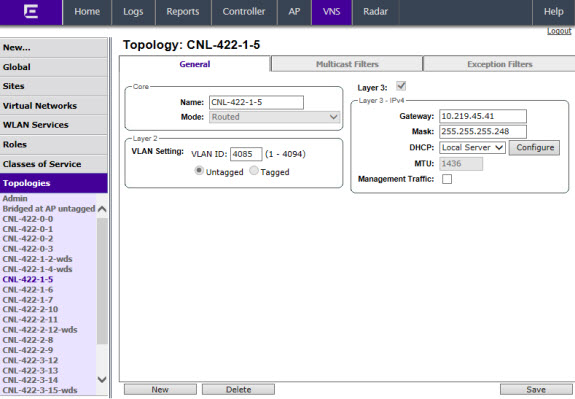IP Address Configuration
The L3 (IP) address
definition is only required for Physical port and Routed topologies. For Bridge Traffic
Locally at EWC topologies, L3 configuration is
optional. L3 configuration would be necessary if services such as DHCP (Dynamic Host Configuration Protocol), captive portal, AP registration (with up to 4 toplogies) are required
over the configured network segment or if controller management operations are intended to
be done through the configured interface.
Bridge Traffic Locally
at AP VNSs can be a defined Mask and do not require the definition of a corresponding IP
address since all traffic for users in that VNS will be directly bridged by the AP at the
local network point of attachment (VLAN (Virtual LAN) at AP port).
To define the IP address for the
topology:
- From the top
menu, click Controller> Topologies, or VNS > Topologies.
- Click New to create a new topology or
select the topology you want to define the IP address for. The Topologies window is
displayed. Depending on the preselected options, two or three tabs are displayed.
Configuring IP Address for Routed Topology
- For IP interface configuration for Routed topologies, configure the following Layer 3 parameters.
- In the
Gateway field, type the controller's own IP address
in that VNS. This IP address is the default gateway for the VNS. The controller
advertises this address to the wireless devices when they sign on. For routed
VNSs, it corresponds to the IP address that is communicated to MUs (in the VNS)
as the default gateway for the VNS subnet. (MUs target the controller's
interface in their effort to route packets to an external host).

Note
The Gateway field only supports IPv4
addresses.
- In the
Mask field, type the appropriate subnet mask for the
IP address. to separate the network portion from the host portion of the
address (typically, 255.255.255.0).
- If desired, enable Management traffic.
- For IP interface
configuration for Bridge Traffic
Locally at
EWC Topologies, configure the
following Layer 3 parameters.
IP Address for Bridged Traffic Locally
- In the
Interface IP
field, type the IP address that corresponds to the controller's own point of
presence on the VLAN. In this case, the controller's interface is typically
not the gateway for the subnet. The gateway for the subnet is the
infrastructure router defined to handle the VLAN.
- In the
Mask field,
type the appropriate subnet mask for the IP address. to separate the network
portion from the host portion of the address (typically,
255.255.255.0).
- Configure Strict Subnet Adherence.
- If
desired, configure AP Registration. If selected, wireless APs can use this
port for discovery and registration.
- If
desired, enable Management traffic.


